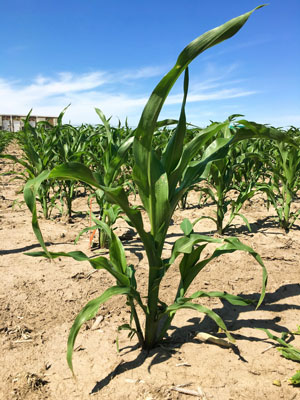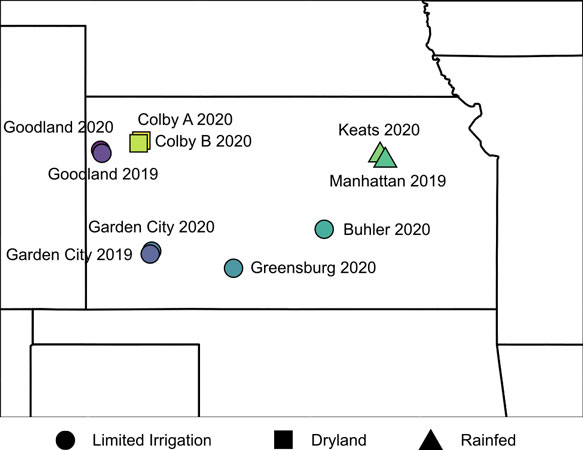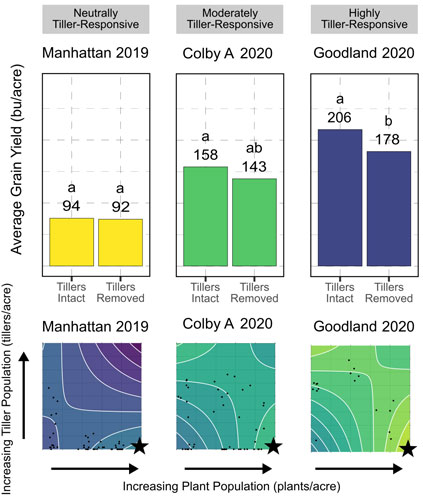Precipitation is a key limiting factor for corn production, particularly in western Kansas. Management strategies, such as reduced plant populations, are commonly used to match crop demands with environmental resource supply. However, these low plant populations encourage the development of secondary vegetative shoots (tillers or “suckers”) when paired with favorable growing conditions (Figure 1).

Figure 1. Corn plant at development stage V7 with two healthy tillers in a 10,000 plant per acre population in Goodland, KS. Photo by Rachel Veenstra, K-State Research and Extension.
Modern corn breeding efforts have resulted in hybrids requiring greater plant populations to achieve yield potential in favorable environments, while subsequently reducing tiller development; however, tillering potential still exists in modern corn hybrids. Corn tillering is a form of plant adaptation to the growing conditions (environmental plasticity). Depending on the hybrid and environmental factors such as light intensity, soil fertility, available water, and temperature, tillers develop early in the growing season.
Historically, corn tillers have been viewed negatively by agronomists and producers, although research studies have presented conflicting results about yield impacts. Few studies have evaluated the direct impact of tiller removal on corn yields, particularly concerning current commercial hybrids and regions with similar climates to Kansas.
New research study in Kansas
With support from Corteva Agriscience and the Kansas Corn Commission, this study included 10 field locations across Kansas in 2019 and 2020 (Figure 2). These sites included a mix of limited irrigation, rainfed, and dryland moisture management strategies. To explore the yield effect of corn tillers, three plant populations (10,000; 17,000; and 24,000 plants per acre), two hybrids (P0657AM and P0805AM), and two tiller removal treatments (tillers intact and tillers removed at development stage V10, tenth-leaf) were tested.
Grain yields, tiller numbers, and environmental conditions were evaluated to understand how each site, density, and hybrid responded to tillering.

Figure 2. Field study locations. Site-years are shown by colored symbols and labeled by location and year; shapes of symbols indicate moisture management. Map by Rachel Veenstra, K-State Research and Extension.
Key outcomes
Tillering did not reduce grain yield in the environments and plant populations tested. In favorable conditions, corn tillers were able to compensate for a reduction in plant density. In all cases, plant density had to be increased to maximize attainable yield in each location (Figure 2).
Key environmental factors increasing positive yield impacts of tillers were favorable soil properties (particularly high organic matter and clay content) and high photothermal-quotient values (influenced by lower temperatures and higher solar radiation) during early corn growth stages (see publication linked below).

Figure 3. Top row: Yields with tillers intact and tillers removed for three example site-years. Letters indicate statistical significance of differences. Bottom row: Modeled impacts of plant population (x-axis) and tiller population (y-axis) on yields for same site-years. Color gradient indicates yield levels, with dark colors representing lower yields and bright colors showing higher yields. The highest predicted yield in each site-year is indicated with a black star.
Summary
Regardless of location, plant density, or yield level for the hybrids tested, tillers did not reduce corn yields. Yield gain from corn tillers is less reliable than increasing plant populations; however, tillers show new potential in this study both as a method of salvaging an unexpected surplus of resources in a good year with below-optimal plant populations, and also as a new factor to consider in replant, hybrid selection, and population management decisions. Tillering could be a useful corn trait in some environmental scenarios experienced in the unpredictable Kansas climate.
This research is also summarized, along with additional graphics, in a new publication from K-State Research and Extension – MF3571 “Tillering Impacts on Corn Yields”. It is available online at: https://bookstore.ksre.ksu.edu/pubs/MF3571.pdf
Financial support provided for this research was provided by Corteva Agriscience, the Kansas Corn Commission, and Kansas State University
Rachel Veenstra, Doctoral student, Farming Systems
rveenstra@ksu.edu
Ignacio Ciampitti, Farming Systems
ciampitti@ksu.edu
Lucas Haag, Northwest Area Agronomist – Colby, KS
lhaag@ksu.edu
Dan Berning, Corteva Agriscience
Paul Carter, Independent Agronomist
Tags: corn tillering yield impacts